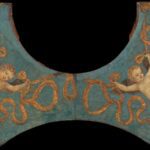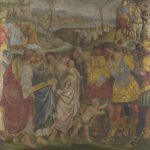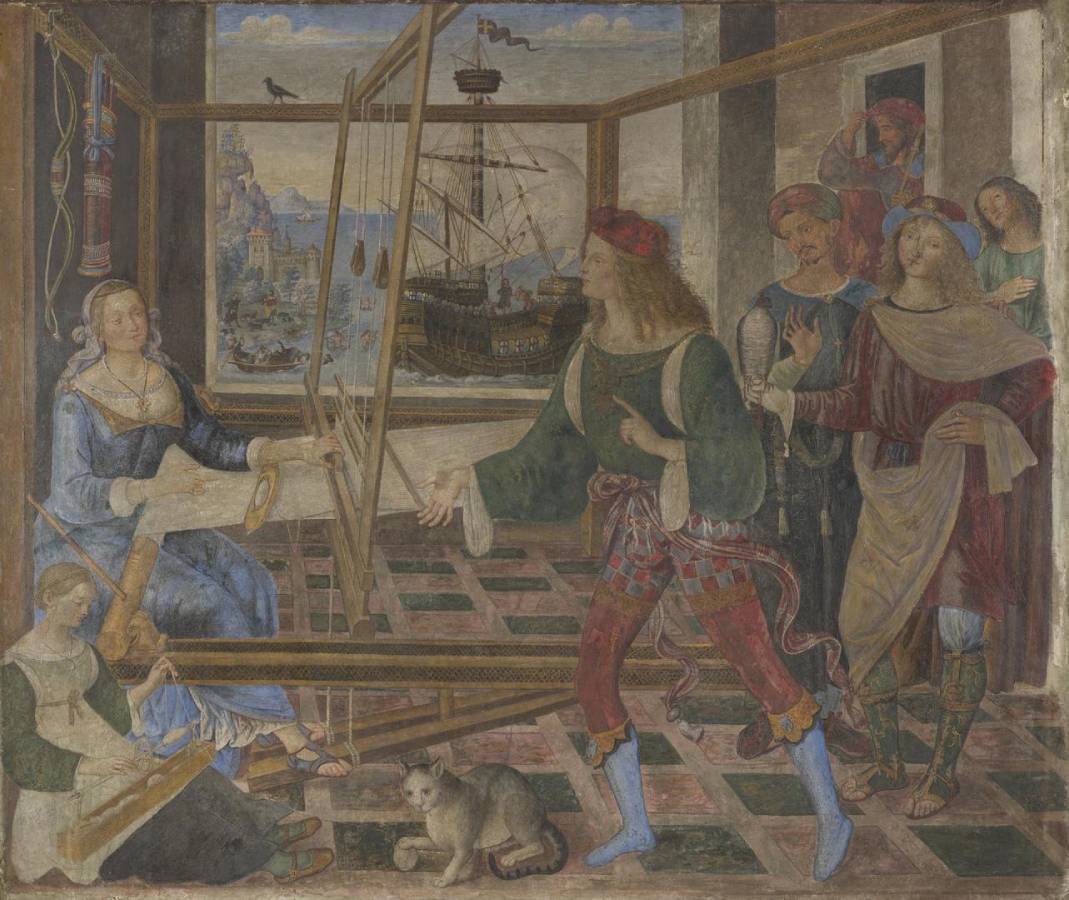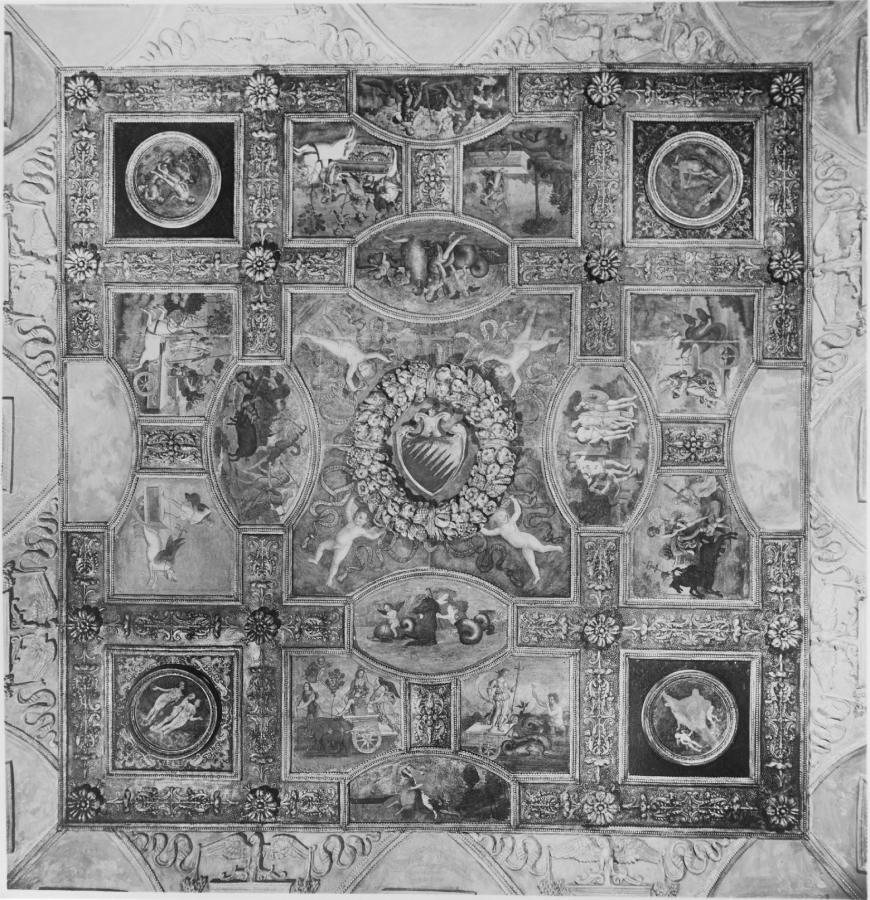Pinturicchio (c.1454-1513)
Ritorno di Ulisse (Return of Ulysses/Penelope with the Suitors)
c.1509
Fresco, detached and mounted on canvas, 125.5 x 152 cm
National Gallery, London
This picture, painted in fresco, was part of a series of eight which decorated the walls of the palace belonging to Pandolfo Petrucci, the ruler of Siena; three survive in our collection. He commissioned them to celebrate the marriage of his son to Pope Pius III’s niece.
This panel shows an episode taken from the Odyssey, an epic poem attributed to Homer which follows the Greek hero Odysseus as he travels home from the Trojan War. His wife Penelope, famous for her fidelity, is shown at her loom: during Odysseus’ 20-year absence she was pursued by other men – seen here queuing up for her attention – but vowed that she would only remarry once her weaving was complete. She ensured that it never was by unpicking her daily labour each night. The central figure who raises his finger seems to be talking to Penelope (he has sometimes been identified as her son Telemachus). He and the suitors wear colourful clothes that look expensive; some have fashionable blond curls and one poses nonchalantly with a falcon, perhaps to show off his hunting skills.
The man entering the room looks different to the other suitors. He carries a staff, often a symbol of a traveller, and his red and blue outfit mirrors the colours of the bow and arrows which hang above Penelope’s head. The association is most likely deliberate: Homer tells us that when Odysseus returned he disguised himself as a beggar and, taking his rivals by surprise, drew his bow and arrows and killed them one by one.
Other episodes in the poem are depicted in the distance. We see Odysseus’ ship, which is decorated with the blue and gold Petrucci coat of arms. The mermaids in the water are the sirens. Homer describes how Odysseus asked his sailors to strap him to the mast as they passed by so that he could listen to their enchanting song without falling victim to its curse – it famously lured sailors to wreck their boats. Sailors in a small boat nearby dive into the water, maddened by the beauty of the singing. On the coast we see Odysseus meeting the witch Circe. They are surrounded by pigs, painted to look like the local Sienese breed, the Cinta Senese, which have a white stripe down their backs. The pigs are in fact humans who have been transformed by Circe’s sorcery.
The choice of subject was relevant for the celebration of a marriage: fidelity and chastity were key virtues for Renaissance women and Penelope was the exemplary bride. It probably had meaning for Pandolfo too, for other reasons: like Odysseus, he also experienced exile and homecoming, having been banished from his hometown of Siena, accused of political intrigue, in the late 1490s. (NG)
The ceiling, composed of detached frescoes of mythological subjects set into casts of the original stuccowork, was painted by Pinturicchio and his workshop as part of the decoration of a room in the Palazzo del Magnifico in Siena. The palace was constructed for the ruler of Siena, Pandolfo Petrucci, (1451–1512) called “Il Magnifico,” whose coat-of-arms decorates the center of the ceiling. According to an eighteenth century description, the walls were frescoed with eight allegorical and mythological scenes by Signorelli, Girolamo Genga, and Pinturicchio. Six of these were detached in 1842/44 and are now in the National Gallery, London and the Pinacoteca Nazionale, Siena. There was also a wooden framework carved by Antonio Barili, parts of which are preserved in Siena, and a majolica tile floor, sections of which also survive. Some of the tiles are dated 1509, the year Pandolfo Petrucci’s son, Borghese, married Vittoria Piccolomini, and the room must have been painted about this time. Pinturicchio was one of the first artists to explore Nero’s Golden House in Rome, and the decoration of the present ceiling is based on a vault in the Golden House. The frescoes from the ceiling, badly damaged, were detached in 1912. One of twenty-two panels (14.114.1–.22) forming the ceiling from the Palace of Pandolfo Petrucci. The general distribution and partition of the ceiling appears to derive from that of a vaulted and painted ceiling in Nero’s Golden House in Rome. Many of the individual figures also seem to derive from antique works of art– especially sarcophagi. (MET)
Frescoes from Palazzo del Magnifico, Siena:
 Pinturicchio (c.1454-1513)
Pinturicchio (c.1454-1513)
Putto con ghirlande
c.1509
Metropolitan Museum of Art, New York
 Signorelli, Luca (c.1445-1523)
Signorelli, Luca (c.1445-1523)
Coriolano convinto dalla sua famiglia
c.1509
National Gallery, London
 Signorelli, Luca (c.1445-1523)
Signorelli, Luca (c.1445-1523)
Trionfo della Castità e Amore sconfitto
c.1509
National Gallery, London
These paintings in fresco (painted directly on to wet plaster) once decorated the walls of a room in the Petrucci family palace in Siena. Each wall was painted with two frescoes, positioned on either side of a doorway or window. The ceiling, which can be seen at the Metropolitan Museum of Art, New York, contained 20 frescoes of mythological scenes, divided by carved, painted and gilded stucco (plaster), produced by Pintoricchio and his workshop. At the centre was the Petrucci coat of arms, surrounded by flying putti (cherubs).
The frescoes were commissioned by Pandolfo Petrucci to celebrate the marriage of his son to the niece of Pope Pius III. The occasion provided an opportunity to show off his fashionable interest in classical history – through scenes from ancient Greek and Roman literature and history, the frescoes illustrate family values and the virtues important to marriage. (NG)
See also:
• Homer (fl. 9th or 8th century BC): The Odyssey (English)

